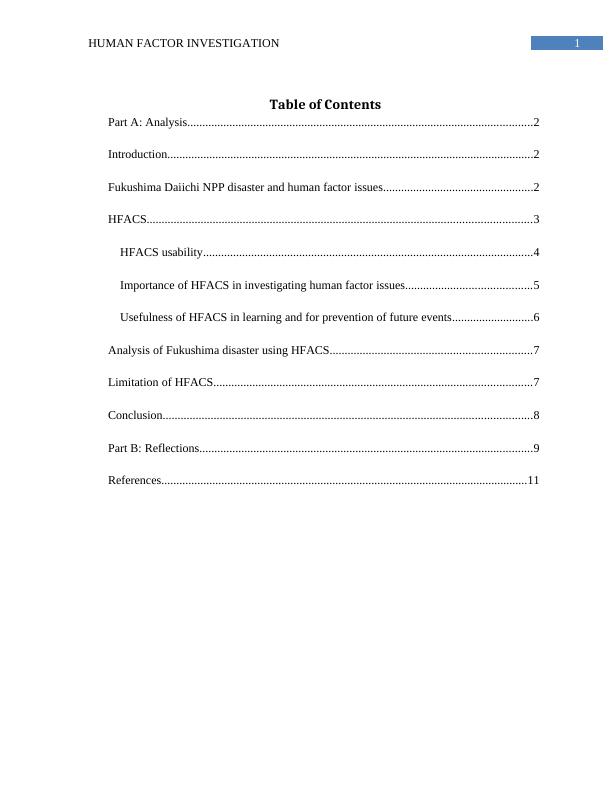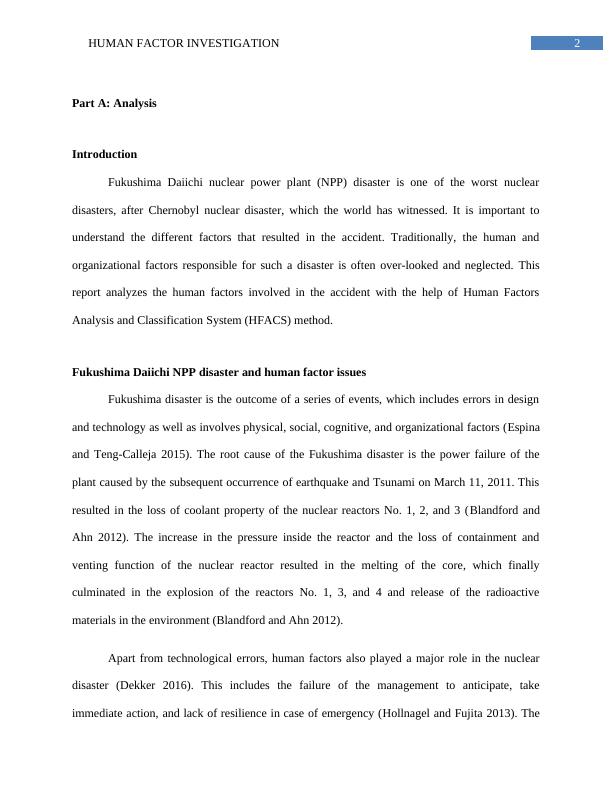Human Factors Investigation in Disasters- Report
Added on 2019-11-29
13 Pages2534 Words241 Views
Running head: HUMAN FACTOR INVESTIGATION Human Factor InvestigationName of the Student:Name of the University:Author Note:

1HUMAN FACTOR INVESTIGATIONTable of ContentsPart A: Analysis...................................................................................................................2Introduction..........................................................................................................................2Fukushima Daiichi NPP disaster and human factor issues..................................................2HFACS................................................................................................................................3HFACS usability..............................................................................................................4Importance of HFACS in investigating human factor issues..........................................5Usefulness of HFACS in learning and for prevention of future events...........................6Analysis of Fukushima disaster using HFACS...................................................................7Limitation of HFACS..........................................................................................................7Conclusion...........................................................................................................................8Part B: Reflections...............................................................................................................9References..........................................................................................................................11

2HUMAN FACTOR INVESTIGATIONPart A: AnalysisIntroductionFukushima Daiichi nuclear power plant (NPP) disaster is one of the worst nucleardisasters, after Chernobyl nuclear disaster, which the world has witnessed. It is important tounderstand the different factors that resulted in the accident. Traditionally, the human andorganizational factors responsible for such a disaster is often over-looked and neglected. Thisreport analyzes the human factors involved in the accident with the help of Human FactorsAnalysis and Classification System (HFACS) method. Fukushima Daiichi NPP disaster and human factor issuesFukushima disaster is the outcome of a series of events, which includes errors in designand technology as well as involves physical, social, cognitive, and organizational factors (Espinaand Teng-Calleja 2015). The root cause of the Fukushima disaster is the power failure of theplant caused by the subsequent occurrence of earthquake and Tsunami on March 11, 2011. Thisresulted in the loss of coolant property of the nuclear reactors No. 1, 2, and 3 (Blandford andAhn 2012). The increase in the pressure inside the reactor and the loss of containment andventing function of the nuclear reactor resulted in the melting of the core, which finallyculminated in the explosion of the reactors No. 1, 3, and 4 and release of the radioactivematerials in the environment (Blandford and Ahn 2012).Apart from technological errors, human factors also played a major role in the nucleardisaster (Dekker 2016). This includes the failure of the management to anticipate, takeimmediate action, and lack of resilience in case of emergency (Hollnagel and Fujita 2013). The

3HUMAN FACTOR INVESTIGATIONincrease in the collisions between the management and the workers and failure to takecollaborative action also increased the severity of the disaster (IAEA 2014). The disaster is alsodue to the cognitive impairment experienced by the workers (Espina and Teng-Calleja 2015).This report helps to understand the active and latent factors responsible for the disasters with thehelp of HFACS.HFACSDrs. Doug Wiegmann and Scott Shappell developed a tool, HFACS, to analyze andinvestigate the apparent and latent factors for the disaster. It is a modified version of Reason’sSwiss Cheese model. According to this model, the different human errors associated with thedisaster are recognized as a barrier that forms a hole in the safety of the industry (Peltomaa2012). There are four distinct barriers identified in an organization (Figure 1). Figure 1. Swiss Cheese Model.Source: Peltomaa (2012).

End of preview
Want to access all the pages? Upload your documents or become a member.
Related Documents
Human Factor Analysis and Classification Systemlg...
|3
|416
|14
